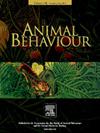The heritability of fear: decomposing sources of variation in marmot flight initiation distance
IF 2.3
2区 生物学
Q2 BEHAVIORAL SCIENCES
引用次数: 0
Abstract
A variety of intrinsic and extrinsic factors shape an animal's antipredator behaviour. Flight initiation distance (FID) is a common way to evaluate antipredator behaviour and is used to assess an individual's shyness or boldness. Numerous FID studies, in a variety of taxa, have shown that FID is a decision that is sensitive to both the costs and benefits of flight. While there is some evidence that individuals may have repeatable FIDs, and there are several genes associated with FID (DRD4 and SERT), few studies have quantified the genetic variance of FID. Knowledge of genetic basis permits us to understand the evolutionary potential of a trait within a population, and heritable variation is yet another mechanism that enables animals to respond to a dynamically changing world. Here we conducted a variance decomposition analysis using the quantitative genetic mixed model (i.e. the ‘animal model’) to identify the degree to which genetic and nongenetic factors explained variation in FID within a population of wild yellow-bellied marmots, Marmota flaviventer. Within our 18-year data set of individually marked individuals, we found significant heritable variation for FID that we estimated at 0.15. These results demonstrate that genetics, in addition to environmental factors, influence an animal's fear response. Understanding evolvability and plasticity of FID could have important implications for conservation.
求助全文
约1分钟内获得全文
求助全文
来源期刊

Animal Behaviour
生物-动物学
CiteScore
4.60
自引率
8.00%
发文量
236
审稿时长
10.2 weeks
期刊介绍:
Growing interest in behavioural biology and the international reputation of Animal Behaviour prompted an expansion to monthly publication in 1989. Animal Behaviour continues to be the journal of choice for biologists, ethologists, psychologists, physiologists, and veterinarians with an interest in the subject.
 求助内容:
求助内容: 应助结果提醒方式:
应助结果提醒方式:


